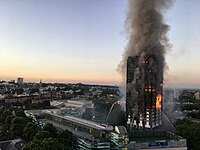
Photo from wikipedia
Abstract One of the main concerns about FRP-reinforced concrete (RC) structures is the performance of the FRP reinforcement under fire exposure. Previous studies showed that fire resistances above 90 min can… Click to show full abstract
Abstract One of the main concerns about FRP-reinforced concrete (RC) structures is the performance of the FRP reinforcement under fire exposure. Previous studies showed that fire resistances above 90 min can be attained if proper anchorage of the rebars is provided and splicing is avoided along spans exposed to fire. However, this topic has not yet been investigated in a comprehensive way. This paper presents experimental investigations on the fire resistance of concrete slab strips reinforced with sand-coated GFRP bars. GFRP-RC (and steel-RC) slab strips were simultaneously subjected to the ISO 834 standard fire and a sustained service load applied in four-point bending. The influence of the following parameters was assessed: (i) concrete cover (2.5 cm and 3.5 cm); (ii) presence of lap-splices with different overlapping lengths (30 cm to 65 cm) directly exposed to fire, and (iii) concrete strength. The results obtained confirm that GFRP-RC slabs can attain relatively long fire resistances provided that the anchorage zones of the rebars (where temperatures were continuously monitored), remain sufficiently cold: the average temperature of the reinforcement along the anchorage length was kept below 108 °C in all tests, slightly above the Tg of the rebars (98 °C). The slab strips reinforced with continuous GFRP rebars attained fire resistances between 80 min and 150 min, failing due to tensile rupture of the reinforcement at midspan for temperatures in the rebars above 570 °C, long after the bond to concrete was lost in most of the heated span. For slab strips with bar splices exposed to heat, the fire resistance was reduced to less than 20 min, highlighting the remarkable impact of this constructive detail on the fire performance. For 30 cm long lap splices, premature failure occurred due to slippage in the splices for a temperature (105 °C) close to the Tg; in slabs with longer overlap lengths, slippage occurred for moderately higher temperatures (146 °C to 176 °C). As expected, the increase in concrete cover, provided an additional thermal protection to the rebars, but resulted only in a slight fire resistance increase. Slab strips with lower concrete strength presented lower fire resistance, due to more extensive cracking, which led to higher (localized) heating of the reinforcement.
Journal Title: Composite Structures
Year Published: 2020
Link to full text (if available)
Share on Social Media: Sign Up to like & get
recommendations!